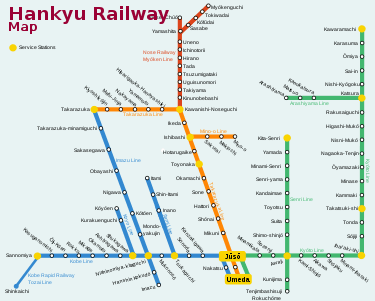Hankyu Senri Line
| Hankyu Senri Line | |||
|---|---|---|---|
|
Senri Line train crossing the Kanzaki River (between Shimo-Shinjō Station and Suita Station), April 2013 | |||
| Overview | |||
| Locale | Kansai | ||
| Termini |
Tenjinbashisuji Rokuchōme Kita-senri | ||
| Stations | 11 | ||
| Operation | |||
| Operator(s) | Hankyu Railway | ||
| Depot(s) | Shojaku | ||
| Technical | |||
| Line length | 13.6 km (8.5 mi) | ||
| Track gauge | 1,435 mm (4 ft 8 1⁄2 in) | ||
| Electrification | 1,500 V DC, overhead line | ||
| Operating speed | 80 km/h (50 mph) | ||
| |||
The Hankyu Senri Line (阪急千里線 Hankyū Senri-sen) is a railway line in Osaka Prefecture, Japan, operated by Hankyu Railway. It was completed on March 1, 1967. Through trains operate to and from the Hankyu Kyoto Line and the Osaka Municipal Subway Sakaisuji Line.
History
The Kita-Osaka Electric Railway opened the Awaji - Senriyama section (1435 mm gauge, dual track) electrified at 600 VDC in 1921.
The Shin-Keihan Railway took the control of the railway in 1923. The Awaji - Tenjimbashi (present-day Tenjimbashisuji Rokuchōme) section opened in 1925 (1435 mm gauge, dual track), electrified at 600 VDC, and in 1928 the voltage was increased to 1500 VDC. With the terminal at Tenjimbashi, this section was a part of the main line of the Shin-Keihan Railway (later the Shin-Keihan Line of the Keihan Electric Railway) connecting Kyoto and Osaka.
The Senriyama - Shin-Senriyama (now Minami-Senri) section opened in 1963, and was extended to Kita-Senri in 1967 (both dual track and electrified). These extensions were to serve the newly developed Senri New Town.
After the Shinkeihan lines were merged to Hankyu in 1943, the role of Tenjimbashi Station as the terminal was gradually shifted to Umeda, the terminal built by Hankyu, and ended in 1969 when the through-running from Tenjimbashisuji Rokuchōme (replacing the old terminal with a single underground platform) to the Osaka Subway Sakaisuji Line commenced. In 1970, the line was one of major access routes to Expo '70 with the temporary Expo West Gate Station.
Service types
In the timetable revised on December 21, 2013,[1] regular trains are classified in three types:
- Local (普通 futsū)
- Sakaisuji Semi-Express (堺筋準急 sakaisuji junkyū) ("SS")
- Limited Express "Hozu" (直通特急 ほづ chokutsū tokkyū) ("H") - in spring and autumn
Stations
| No. | Station | Japanese | Distance (km) | SS | H | Transfers | Location |
|---|---|---|---|---|---|---|---|
| Operations continue to Tengachaya Station on the Osaka Municipal Subway Sakaisuji Line. | |||||||
| K11 | Tenjimbashisuji Rokuchōme | 天神橋筋六丁目 | 0.0 | SS | H | Osaka Municipal Subway Sakaisuji Line (K11, through trains), Tanimachi Line (T18) | Kita-ku, Osaka |
| HK-87 | Kunijima | 柴島 | 2.2 | Higashiyodogawa-ku, Osaka | |||
| HK-63 | Awaji | 淡路 | 3.5 | SS | H |
| |
| HK-88 | Shimo-Shinjō | 下新庄 | 4.4 | ||||
| HK-89 | Suita | 吹田 | 6.0 | Suita, Osaka | |||
| HK-90 | Toyotsu | 豊津 | 6.9 | ||||
| HK-91 | Kandai-mae | 関大前 | 7.8 | ||||
| HK-92 | Senriyama | 千里山 | 8.6 | ||||
| HK-93 | Minami-Senri | 南千里 | 10.2 | ||||
| HK-94 | Yamada | 山田 | 11.6 | Osaka Monorail Main Line | |||
| HK-95 | Kita-Senri | 北千里 | 13.6 | ||||
Abandoned stations
- Nagara (Tenjimbashisuji Rokuchome - Kunijima) - abandoned on February 1, 1944
- Suita (first) (Shimo-Shinjo - Shiyakusho-mae) - consolidated to Shiyakisho-mae Station on April 10, 1964 and Shiyakusho-mae Station was renamed Suita Station.
- Kadancho (Toyotsu - Daigaku-mae) - consolidated to Kandai-mae Station on April 10, 1964
- Daigaku-mae (Kadancho - Senriyama) - consolidated to Kandai-mae Station on April 10, 1964
- Expo West Gate (Minami-Senri - Kita-Senri) - used from November 10, 1969 until September 14, 1970
References
This article incorporates material from the corresponding article in the Japanese Wikipedia
- ↑ News release on September 20, 2013 - Hankyu Corporation
